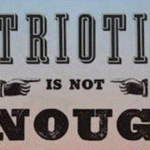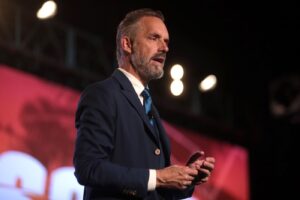Anthony Esolen is the contemporary incarnation of GK Chesterton. The simple and beautiful prose, the acute diagnostic precision, the commonsense appeal to and on behalf of everyday things, the recipe for renewal—all these things Esolen shares with Chesterton, the preeminent cultural physician of the early twentieth century. Like Chesterton, Esolen bluntly identifies our problems. And like him, Esolen’s solution centers on God and faith, learning and virtue, and a robust sense of human nature.
“I shall decry the decay of civilization,” Esolen announces at the outset of his newest book, Out of the Ashes: Rebuilding American Culture. And decry he most certainly does. His diagnosis of American culture is almost shocking in its candor—“pungent,” as the book’s dust jacket describes Esolen—but it is all the more sound for that.
The form of Esolen’s criticism fits its content. Chapter One, subtitled “The Restoration of Truth-Telling,” inaugurates a book-length, withering critique of the web of lies pulsating at the heart of American culture. This web is spun and maintained by the “mass” institutions: media, business, entertainment, and government. The most impressive obstacle to restoration of culture is the persistent insistence that unreality is real: that boys can be girls, that men and women are the same, that the unborn child is not a person, that divorce is okay for ourselves and the kids, that literature (especially poetry) and culture are fungible subjects of inquiry, and so on. And we aren’t simply mistaken about such things, according to Esolen. “Children lie to hide the bad things they have done,” he says. “So does everyone else.”
The necessary remedy for such cant and for the political paradigms and correctness that bolster it is a total rejection of their terms and conditions—a rejection that Esolen boldly models. We must learn anew to read and speak, to sing and work and dance and pray, and to build and cherish beautiful things. If Esolen’s envisaged culture strikes us as quaint, as something only even desirable before the Industrial Revolution or the invention of the television, so much the worse for us. “If tradition is the handing on of cultural and artisanal knowledge, and if we have taught ourselves in our smugness that we can dispense with it, then we will become cultural and artisanal incompetents.” This prophecy embraces the skeptic along with the smug.
Start your day with Public Discourse
Sign up and get our daily essays sent straight to your inbox.Restoring Education
Esolen advocates a retrieval of the beautiful as a standard for architects and artists. Our churches, schools, and common places of life have traded the aspiration to beauty for the enthronement of “efficiency,” and we are stuck with drab and dull venues because of it.
What goes on inside our buildings is similarly dreary. Esolen argues that we must restore the school as a place of true culture and learning, not of servile adherence to political fancies. There are only two things wrong with our schools: everything that children learn there, and everything they don’t. Among the latter, Esolen prioritizes grammar as the key that unlocks an understanding not only of one’s own and other languages but of many other realms of knowledge as well—history and literature and theology and poetry, and even biology (the grammar of the body) and chemistry (a grammar whose “elements” are the elements themselves).
As it is, our schools give us a “multicultural” education that is just a cultural solvent and a cover for the stringent imposition of a rigid and oppressive orthodoxy. Public schools avoid religious questions at the cost of censoring the most human questions. The natural impulse for patriotism is snuffed out by self-righteous condemnation of our grandparents and the figures of the past. The stories composing our history are neglected in favor of whatever creed the child’s primary educators—the state—happen to favor. Our schools have become a “dead loss.”
Higher education is no better off. In some cases, it is much worse. There, political correctness and identity politics dominate discourse. Learning is no more. As Esolen observes, “If a professor must negotiate an emotional and verbal and political minefield before he opens his mouth, then he . . . is a servile functionary, no matter his title and no matter how well he is paid.” Your average state university is an expensive program in aggressive miseducation, and most Catholic universities are not much different. “Whorehouses and mental wards would be much cheaper,” Esolen suggests. “They might well be healthier, too.”
His solution is to form new colleges or reform old ones, modeled on institutions like Christendom College, Patrick Henry College, Thomas Aquinas College, The Catholic University of America, and the like (interested parents and high schoolers can reference pages eighty to eighty-one for a longer list), where real community is cemented around prayer and a pursuit of shared learning of the deep things. Places like Georgetown try to “fool the customers,” Esolen writes, but we should be fooled no longer. Financial donations should be directed toward these new or old-and-recently-reformed institutions where our money can make a massive institutional difference. “The true patriot does not send a check to Benedict Arnold, hoping that some of it will find its way back to Washington’s army.”
Like-minded professors need to establish informal networks of recommendation so that they can track each other’s best and brightest students and be prepared to get them positions from which they can teach real culture. We need to assure the best of our undergraduates and graduate students that they will find a place to work, whether in a classical high school or in a faithful faith-based college. Were we to do this, Esolen reasons, excellent students could trust that they will be hired out of their graduate programs, instead of fretting that their untrendy orthodoxy and general sanity will render them unappealing.
Authentic Manhood and Womanhood
The chapters on restoring authentic manhood and womanhood are rich and provocative. Esolen’s thesis is that since “men and women are different from one another, down to the roots—down to the cells,” single-sex education is the way to appropriately shepherd boys and girls into the full development of their own gifts.
Lauding the Greek gymnasia and the medieval artistic guilds, he asks whether today’s co-ed institutions “succeed as well” as these systems that produced cultural genius on a massive scale. “All art studios are co-educational now. So where is the Renaissance?”
A single observation can summarize the chapter on womanhood: If a woman professionally arranges flowers, or cooks fine Italian meals, or plays violin for an orchestra, or gives singing lessons, she will be praised for engaging her gifts and “making something of herself,” even if she returns home from her day’s labors and is unwilling or unable to care for her children. But if a woman “well versed in all of the household arts” does all of these things for those whom she loves and cares about the most, “we shake our heads and say that she has wasted her talents” by staying at home.
Recovering Culture
The final two chapters concern the recovery of the polis and a reorientation toward things divine. In Esolen’s view, the state has become a god, claiming a pseudo-divinity for itself and proscribing worship of all other gods. “Jabba the State,” the “Metastate,” has absorbed “every human thing into itself.” Consequently, we “now have what every single one of the founders, federalists or anti-federalists, would have considered tyrannical.” We are what the ancient Greeks would have considered both idiots and barbarians: idiotes, because we aren’t interested in living truly political lives, barbaros, because we are deprived of that opportunity even where we do want it by a massive federal government.
Esolen’s suggestions here revolve around the principle of subsidiarity: what is locally manageable is not only most efficiently managed but is the occasion for real human formation and engagement, the theater in which deeply personal stories develop. We need to engage our imaginations and “try to revive social life on our own”—apart from the state’s blessing, for we can count only on its malefaction.
That revival of social life cannot, however, take as its aim the revival of social life. The renewal of culture will never work if it is pursued as the highest good. “He who would save a culture or a civilization must not seek first the culture or the civilization, but the Kingdom of God,” Esolen writes, and all these things will be given him besides. Those marked with the character of Christ will not play the futile games of this world and will not serve other gods before the living God. They will strive for godliness, piety, and virtue, and in so doing will cultivate their souls. “Take away the devotion and you take away the soul.” In other words: first things first.
We Need Not a Whimper, But a Bang
Reading Esolen’s book is in itself a rather intimidating cultural experience. But the author’s broad erudition testifies to the vision he promotes, a vision that can speak for itself but that does benefit from a prophetic summons. “Reality is what it is,” Esolen says in what could summarize the book’s outlook. “I am . . . but an observer of human nature.”
This book’s target audience is not the committed antagonist of the vision that Esolen beautifully propounds. The author has thrown caution to the winds, since in his judgment such caution is incommensurate to the dire need for a complete about-face. “Sometimes entire civilizations do decay and die, and the people who point that out are correct,” he explains of the urgency with which he writes. Esolen’s regular readers will love this book.
To those who are less sympathetic, I would say: Step back and reflectively engage the vision on offer here, rather than getting worked up by some of the particular judgments or demanding more nuances and less strident rhetoric. The rebirth of American common life will be the fruit of a cultural bang, not a whimper.













